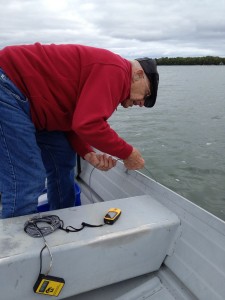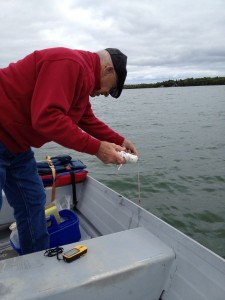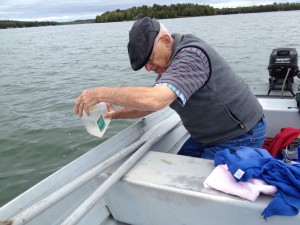On September 22, I (Jennifer Ikeda) joined Paul Mahlberg for a lesson during his third Kangaroo Lake water testing of 2013. This is an activity Paul has undertaken since 1993; the KLA is fortunate to have our own resident scientist who has committed his time and effort to provide an excellent history of important characteristics of our lake.
Paul measures, records and submits samples and data to the Wisconsin Department of Natural Resources Citizen Lake Monitoring Network. His measurements include:
- Secchi disk measurement of the water clarity
- Water temperature
- Water pH
Additionally he prepares and submits samples that the DNR labs test for phosphorus content and chlorophyll, which are used to determine the Trophic state of Kangaroo Lake:
- Phosphorus, along with nitrogen is an essential nutrient for the plants and animals that make up the aquatic food web. Since phosphorus is typically the nutrient in short supply in most fresh waters, even a modest increase in phosphorus can fuel harmful algae, excessive plants and muddy water in many lakes and rivers. [1]
- Chlorophyll levels are a direct way of tracking algal growth and an indirect indicator of nutrient levels. [2]
Looking at the Trophic State Index (TSI) graph for Kangaroo Lake, we are Mesotrophic, trending toward Eutrophic. What can we do to help contribute to the health of Kangaroo Lake?
- Reduce input of Phosphorus – Phosphorus is used in fertilizers, detergents, and animal feed. It’s in our food, in our waste, and detergents. Our fertilizers and detergents should be phosphorus-free, our pet and yard wastes disposed of properly, and our septic systems operating properly. [2]
- Encourage growth of aquatic plants – Aquatic plants, such as bulrushes, not only help to provide food and shelter for fish and to reduce erosion – they also help improve water clarity and quality by absorbing and breaking down phosphorus and other nutrients, thus making them unavailable to algae. Obey slow – no wake within 100 feet of the shore (200 feet for jet skis) and avoid damage to existing bulrushes and healthy plants. Also join in efforts around bulrush restoration and tree drop. [3]
To learn more about water testing on Kangaroo Lake and how to access the TSI graph and other historical data, please visit the Learning Center on the association’s website, www.kangaroo lake.org and click on Water Quality Sampling Data and Proces: Dr. Paul Mahlberg
References:
[1] http://dnr.wi.gov/news/mediakits/mk_phosphorus.asp
[2] http://www.ysi.com/media/pdfs/T606-The-Basics-of-Chlorophyll-Measurement.pdf
[3] http://www.dnr.state.mn.us/shorelandmgmt




